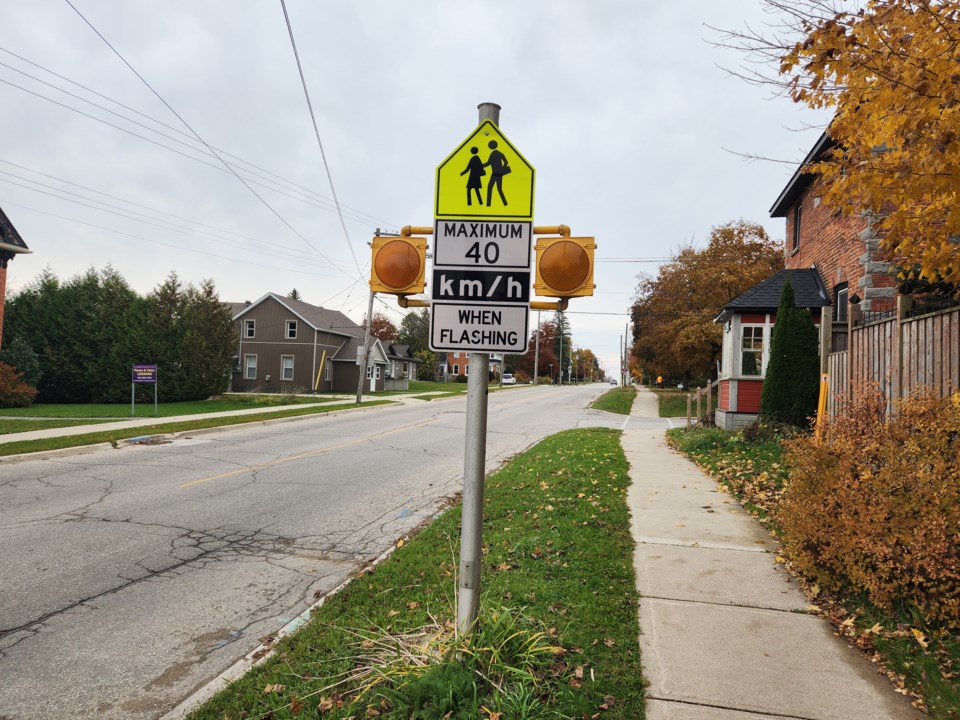Automated speed enforcement (ASE) is a tool that local municipalities can use to improve safety on roads, but it’s not a magic solution that will end speeding on local roads, heard Grey Highlands' elected representatives at a meeting this week.
Grey Highlands council received that message at a special committee of the whole meeting on Oct. 25. Jeff Barten, a representative from LAS (the wing of the Association of Municipalities that delivers services), spoke to council about ASE, which is a modern form of photo radar.
Provincial regulations allow municipalities to use ASE in special community safety zones and areas where speeding is a concern. LAS is currently developing a pilot program that will – if all goes to plan – open up ASE to all interested municipalities in early 2024.
Barten told council that ASE is a tool that can be used to reduce concerns about speeding in specific problem areas. He cautioned councillors that the program isn’t necessarily a revenue generator and is geared towards addressing safety issues.
“The focus is on safety. It isn’t necessarily on the revenue side,” said Barten. “It is definitely not a quick way to make money. It may not be a revenue-positive venture.”
Barten told council that once the program becomes active, LAS would offer three main pieces: supply of the cameras and equipment, violation processing and adjudication of ticket disputes.
“It’s turn-key, flexible and geared towards small and medium municipalities,” he said.
LAS has entered an agreement with the City of Barrie to be the processing municipality as the program starts up. Barten said LAS has received expressions of interest from 70 municipalities, with 38 of them having a population of 20,000 or less.
Installing an ASE system requires a municipality to put up signs alerting drivers that the technology is being used to enforce speed limits. The technology does live track vehicles and takes a picture of those violating the speed limit. The technology is calibrated with a threshold speed for when a ticket is generated, which means drivers going one or two kilometres over the limit would not be ticketed.
Barten told council it would cost an estimated $25,000 - 40,000 for a camera leasing set-up, depending on the size of the system a municipality decided to use. There are no upfront fees, but LAS receives $22 per ticket for the processing of the tickets generated. He estimated that a program generating 70 tickets a month would be a break-even proposition.
“This is meant to be a not-for-profit model,” he said. “This is not meant to be a cash grab for anyone. We want to make our streets safe.”
Council did not make any decisions about the system at the meeting and voted to receive the report and presentation for information. However, members of council did express a range of different views on the possibility of using ASE.
“Big Brother is watching you,” said Mayor Paul McQueen, in reference to author George Orwell’s famous book about state surveillance - 1984. McQueen also noted that Grey County currently receives all revenue from provincial offences and for Grey Highlands to recoup the costs of an ASE system that would have to change.
Barten said local municipalities can put in place a system of administrative penalties to receive fine revenue from the program.
Coun. Dan Wickens asked about the sign requirements for the programs.
“Are there signs all around the municipality? How is the public notified when a program like this is going on?” he asked.
Barten said signs are mandatory. First, the municipality must put up 90-day warning signs wherever an ASE system is going to be implemented. Once the cameras are in place, signs warning drivers must be located within a certain distance of the cameras. The system is connected through the local phone network to upload the data for processing.
Coun. Paul Allen said he was having trouble digesting setting up an expensive system to catch speeding drivers, but then also warning them with signs.
“I’m trying to get my head around warning them far enough ahead that they can slow down,” said Allen.
Throughout his presentation, Barten stressed that ASE is a tool that can help with road safety, but that it wasn’t a remedy that would end speeding.
“It’s not a silver bullet. It’s not going to slow everybody down,” he said.
Coun. Nadia Dubyk said she appreciated that the program was not being presented as a perfect solution.
“I appreciate that you started with: 'this isn’t a silver bullet.' This is one tool in our tool kit to help manage speed,” she said.



